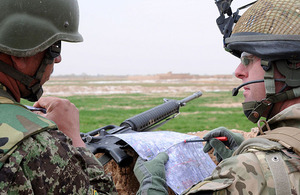Continuous and unrelenting progress in Helmand
The Commanders of ISAF troops in Helmand province, where the vast majority of UK personnel deployed to Afghanistan are working, gave a briefing yesterday on progress made over the last 12 months.

Royal Irish soldiers work side-by-side with their Afghan National Army counterparts during Op TORA ZHEMAY VI [Picture: Crown Copyright/MOD 2011]
US Major General Richard Mills, Commanding Officer Regional Command (SW) and Brigadier George Norton, Deputy CO RC (SW) spoke to the British media via a crackling video link between MOD Main Building and Camp Leatherneck (Bastion) in Helmand province.
General Mills described the situation in Helmand province a year ago, when he first took up command as CO RC(SW), as a very dark place:
There was an active powerful insurgency controlling the bulk of the population and the majority of the terrain,” he said.
The insurgent’s presence threatened the very existence of the government he continued, and said that the roads and such infrastructure as there was all came under their influence. In addition to all of that, they also were able to control the pace and scope of the violence using the production of narcotics to fund their activities, while simultaneously poisoning the rest of the world:
It was an insurgency that was very well organised with an efficient supply chain,” said the General.
At that time the Coalition was concentrating on controlling areas close to the river, it was very inwardly focussed maintaining small security bubbles:
Our job when we arrived was to secure the populated areas, control the freedom of movement, reduce the insurgency and work alongside the Afghan National Security Forces and increase their capability.
In addition to this, the task was to strengthen the government and convince the local population to trust the system of government and see it as the way forward:
Today it’s quite a different province,” said General Mills.
Progress has been sustained, it’s been continuous, and it’s been unrelenting. Coalition forces now have unbroken control of the Helmand river valley, each population centre of RC(SW) is under our control, the security bubbles have been connected, and they’ve been extended, and the land between them is ours.
Much of the insurgents have been pushed into the desert, he added, and in more than 2,000 engagements the Coalition forces have always prevailed. The result being that insurgent encounters are now reduced to what the troops describe as “shoot and scoot” skirmishes. They rarely stand and fight. The insurgent weapon of choice now is the improvised explosive device (IED):
Our technology and our training is increasingly reducing that threat. We find three IEDs for each that strikes,” said General Mills.
The insurgent supply line has been broken, we believe that he is suffering from a lack of money and recruits, and we are able to track them wherever they move, giving them no rest.
There has been a marked improvement in the quality of roads in the area, and many have been constructed. Security is such that locals are able to use them both day and night. Routinely, district governors and officials travel by road, which, the general said, would have been completely impossible 12 months ago.
Radio stations are now free to broadcast news, prayer and education and keep the local populations properly informed, not shying away from criticising coalition actions when they feel it is justified:
There is still much to do, for example in the area north of Sangin, and we need to link security bubbles out to Kandahar. We also need to address problems with the Pakistan border, at some point in the future,” said the General. “But it’s all come at a price with the deaths of 179 coalition force troops killed in action.
Brigadier Norton said that Operation MOSHTARAK, launched in February 2010, had done a great deal to drive out the insurgent and instil the public’s trust in their own armed forces:
Over the last 12 months the Afghan 215 Brigade has grown by 35 per cent to around 12,000, and the uniformed police has increased from three to 5,000. And local police forces have now been stood up in five districts,” said Brigadier Norton.
He added that this progress in the recruiting and training of the Afghan police had resulted in Afghan civilians now trusting them to serve and protect their interests.
We have taken the initiative over the last 12 months. Our challenge is now to maintain it and develop it.
The Brigadier said that the combination of US, UK and Afghan security forces had made a convincing team.
General Mills said that it was difficult to say when the ANSF would take over full responsibility for security:
That’s a decision that’s taken at a high level,” he said.
But we are setting the conditions for that to happen and I’d say we are on the right flight path to match what General Petraeus has set down in his plan.
One test for this is simple, and I’d say one, which the ANSF are already passing is the confidence that the local people have in them.
Regarding the police force in Helmand province, a year ago they were seen as a bunch of thugs simply out to enrich themselves. That’s now changed. They are now looked upon as people who protect and serve. It is significant that the locals themselves are increasingly coming forward with information about things such as weapons caches.
Brigadier Norton added that in the Lashkar Gah district there had been many examples of ANSF dealing with situations with confidence and in a professional way without feeling the need to request ISAF assistance:
All of which shows we are heading in the right direction,” he concluded.